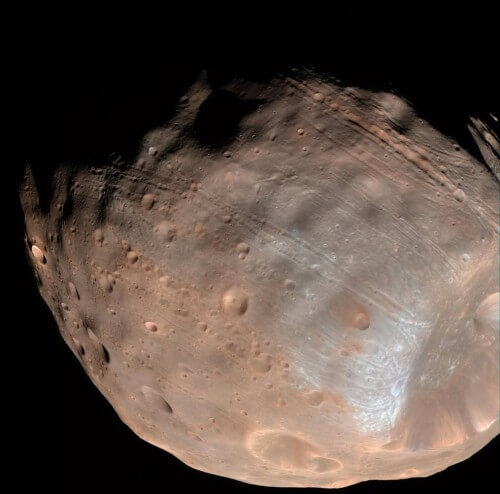This is according to a model developed by researchers from NASA and the University of Arizona, which places the blame on the tidal forces between Mars and Phobos

The long, shallow grooves stretching across the surface of Phobos are likely the first signs of a structural breakup that will eventually destroy this Martian moon.
Phobos, the larger of the two Martian moons, orbits Mars at a low altitude - 6,000 kilometers above the surface, making it the closest moon to the planet it orbits in the entire solar system. The gravitational force of Mars is pulling Phobos towards it at a rate of 2 meters per century, and therefore it is expected to disintegrate within 30-50 million years and crash on Mars.
"We believe that Phobos has already begun to break up, and the first sign of this is the formation of cracks," says Terry Harford of NASA's Goddard Space Flight Center in Maryland. The findings of Harford and his colleagues were announced on November 10, 2015 at the annual meeting of the Division of Planetary Sciences of the American Astronomical Society held in Maryland.
The craters of Phobos have long been thought to be fissures caused by the impact that created the Sticky Crater. The impact was so strong that it almost killed Phobos. However, the scientists finally determined that these grooves do not rotate in a circle from the crater itself, but from a center that is not far from it.
Recently, researchers suggested that these grooves may have been formed by many small impacts of materials ejected from Mars, however the new model of Hatterford and his colleagues supports the position that the grooves are more stretch marks resulting from the slow disintegration of Phobos due to tidal forces. The gravitational attraction between Mars and Phobos produces these tidal waves, similar to those in the Earth-Moon system that cause ocean tides and the egg-like shape of these two bodies, instead of being perfect spheres.
This explanation was already considered decades ago, after Viking spacecraft transmitted photographs of Phobos to Earth. At the time, Phobos was considered rocky throughout, and when tidal forces were calculated the pressure was too weak to crack a solid moon of this size. However, the current assessment is that Phobos is a pile of gravel, whose components barely hold each other thanks to gravity, surrounded by a layer of regolith (rock dust) 100 meters thick.
The funny result of the model is that it shows that Phobos has a type of mantle that functions as an external liver that traps it," says Eric Aspo from the School of Earth and Space Studies at the University of Arizona in Tampa and a partner in the study. "It makes sense when you think about powdery materials in microgravity, but it's pretty counterintuitive."
The inner material can warp easily because it has very little traction, thus forcing the outer layer to readjust. The researchers believe that the outer layer of Phobos is elastic and stretched but weak enough for the pressures of the tidal forces to cause it to disintegrate.
This means that the tidal forces acting on Phobos can generate more than enough stress to crack the surface. The stress fractures predicted by this model agree well with the grooves seen in photographs of Phobos. This explanation also fits with the observation that some of the grooves are younger than others, which is consistent with the view that this is an ongoing process.
The researchers estimate that a similar fate may also befall Triton, Neptune-Rahab's moon, which is also slowly falling into Neptune, and which also has a similarly cracked surface.
This may also be true for planets outside the solar system: "We cannot observe these planets due to their distance but the study may help us understand the behavior of these systems, because every planet that falls into its host star (and there are quite a few holidays close to their suns) rose tear apart the same way, Harford said.

2 תגובות
Now is the time to enter a short position on the Mars real estate index
I would not build on 50 million years if I were to build a house on Mars.